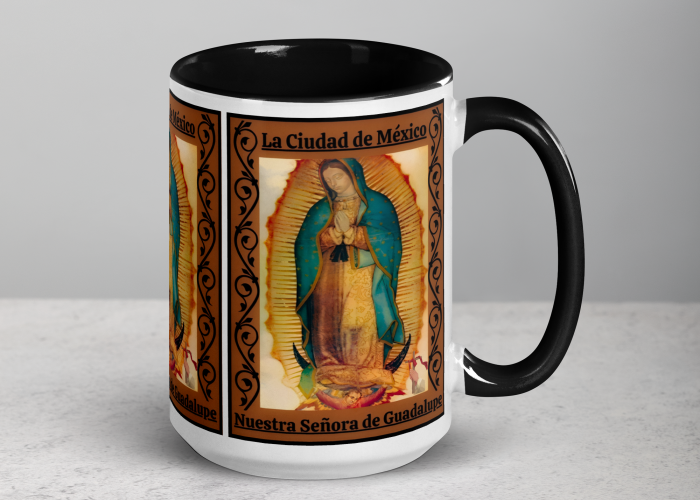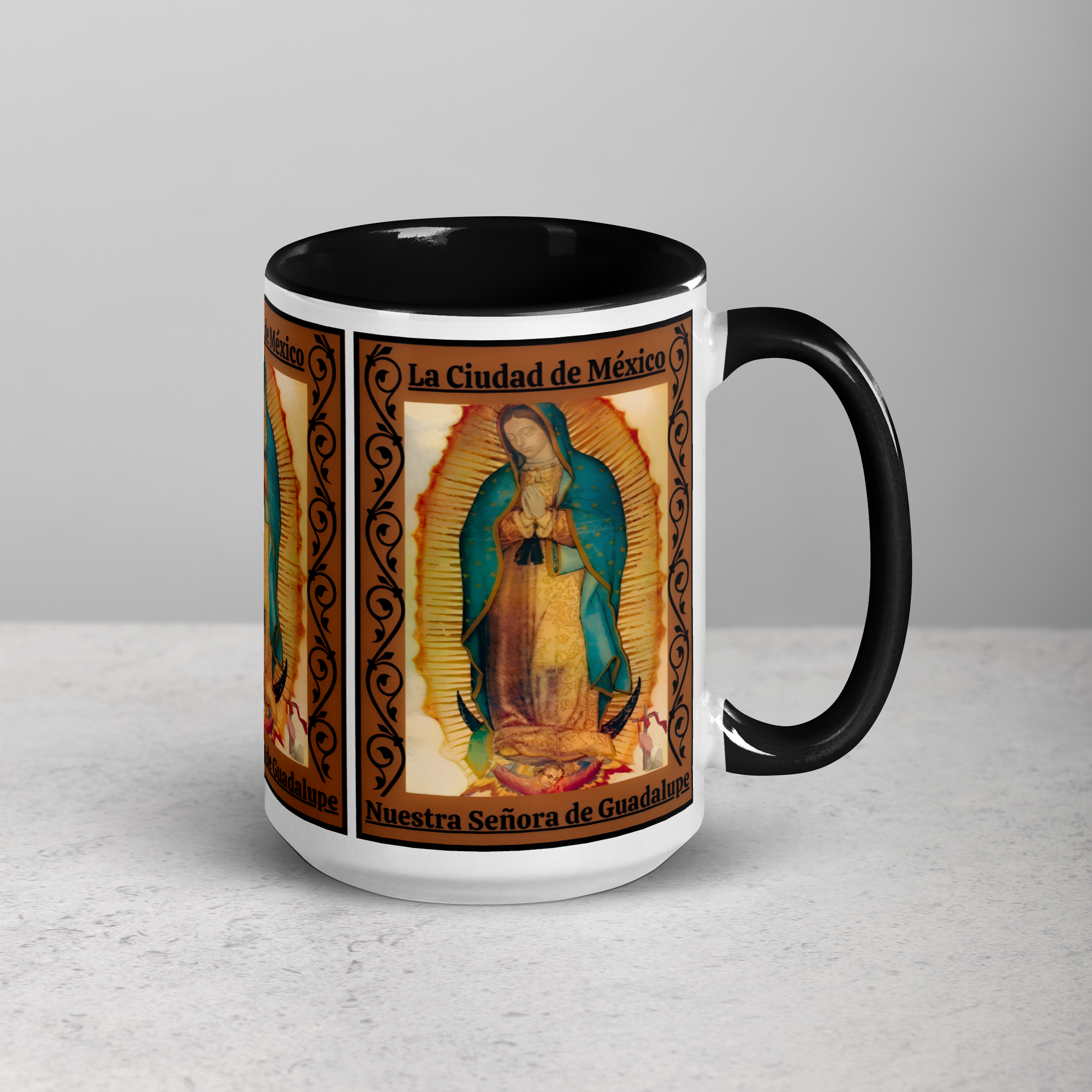



Scrie-ne ce problema ai în legătură cu acest anunț!
Comment
Nuestra Señora de Guadalupe (la Virgen de Guadalupe) México Taza de café 15oz (443.60ml) Our Lady of Guadalupe Mary Mother of Jesus Mexico!
Clothes and Accessories
Accessories
Other accessories
Folosit
Individual
Nu
Details
Nuestra Señora de Guadalupe (la Virgen de Guadalupe) México Taza de café 15oz | eBay
eBay item number:266887752949
Ebay seller: Oceansidecali777
Nuestra Señora de Guadalupe (la Virgen de Guadalupe)
México Taza de café Premium Mug 15oz (443.60ml)
Coffee Cup
Our Lady of Guadalupe
The Virgin of Guadalupe
Mary, mother of GOD (Jesus Christ)
ROMAN-CATHOLIC
HOLY SAINTS CHRISTIANITY
ARTWORK & GIFT IDEA!
Nuestra Señora de Guadalupe
(la Virgen de Guadalupe) México
Taza de café
Premium Mug 15oz Coffee Cup (443.60ml)
Our Lady of Guadalupe
the Virgin of Guadalupe
Mary, mother of GOD (Jesus Christ)
ROMAN-CATHOLIC
HOLY SAINTS
CHRISTIANITY
ARTWORK & GIFT IDEA!
Ceramic
This Coffee Mug holds 15oz (443.60ml)
Height: 4.69 inches (11.9 cm)
Diameter: 3.35 inches (8.5 cm)
White print area
dark blue handle and interior
Dishwasher and microwave safe.
These are high-quality cups
that cannot be found
at just any place.
They are uniquely designed.
There are packed securely
and shipped with tracking numbers.
Go ahead, purchase one for yourself
and/or someone you know.
Thank you for shopping with us!
History:
Our Lady of Guadalupe (in Spanish: Nuestra Señora de Guadalupe), also known as the Virgin of Guadalupe
(in Spanish: Virgen de Guadalupe), is a Catholic title of Mary, the mother of Jesus Christ associated with a series of five Marian apparitions, which have occurred in December 1531, and a venerated image on a cloak enshrined within the Basilica of our Lady Guadalupe in Mexico City. The basilica is the most-visited Catholic shrine in the world, and the world's third most-visited sacred site.
According to Nican Mopohua, a 17th-century account written in the native Aztecan language, the Virgin Mary appeared four times to Juan Diego, an Aztecan peasant and once to his uncle, Juan Bernadino. The first apparition occurred on the morning of Saturday, 9 December 1531 (Julian calendar, which is December 19 on the (Gregorian calendar in present use). Juan Diego experienced a vision of a young woman at a place called the Hill of Tepeyac, which later became part of Villa de Guadalupe, in a suburb of Mexico City. According to the accounts, the woman, speaking to Juan Diego in his native Aztecan language, identified herself as the Virgin Mary, "mother of the very true God". She was said to have asked for a church to be built at that site in her honor. Based on her words, Juan Diego then sought the Archbishop of Mexico City, Fray Juan de Zumárraga, to tell him what had happened. Not unexpectedly, the archbishop did not believe Diego. Later the same day, Juan Diego again saw the young woman (the second apparition), and she asked him to continue insisting.
The next day, Sunday, December 10, 1531 (Julian calendar), Juan Diego spoke to the archbishop a second time. The latter instructed him to return to Tepeyac Hill and to ask the woman for a truly acceptable, miraculous sign to prove her identity. Later that day, the third apparition appeared when Juan Diego returned to Tepeyac; encountering the same woman, he reported to her the archbishop's request for a sign, which she consented to provide on the next day (December 11).
By Monday, December 11 (Julian calendar), however, Juan Diego's uncle, Juan Bernardino, became ill, which obligated Juan Diego to attend to him. In the very early hours of Tuesday, December 12 (Julian calendar), Juan Bernardino's condition having deteriorated overnight, Juan Diego journeyed to Tlatelolco to get a Catholic priest to hear Juan Bernardino's confession and help minister to him on his deathbed. To avoid being delayed by the Virgin and ashamed of having failed to meet her on Monday as agreed, Juan Diego chose another route around Tepeyac Hill, yet the Virgin intercepted him and asked where he was going (fourth apparition); Juan Diego explained what had happened and the Virgin gently chided him for not having made recourse to her. In the words which have become the most famous phrase of the Guadalupe apparitions and are inscribed above the main entrance to the Basilica of Guadalupe, she asked "¿No estoy yo aquí que soy tu madre?" ("Am I not here, I am your mother?"). She assured him that Juan Bernardino had now recovered and told him to gather flowers from the summit of Tepeyac Hill, which was normally barren, especially in the cold of December. Juan Diego obeyed her instruction and he found Castilian roses, not native to Mexico, blooming there. According to the story, the Virgin arranged the flowers in Juan Diego's tilma, or cloak, and when Juan Diego opened his cloak later that day before Archbishop Zumárraga, the flowers fell to the floor, revealing on the fabric the image of the Virgin of Guadalupe.
The next day, December 13 (Julian calendar), Juan Diego found his uncle fully recovered as the Virgin had assured him, and Juan Bernardino recounted that he also had seen her after praying at his bedside (fifth apparition); that she had instructed him to inform the Archbishop of this apparition and of his miraculous cure; and that she had told him she desired to be known under the title of 'Guadalupe'.
The archbishop kept Juan Diego's mantle, first in his private chapel and then in the church on public display, where it attracted great attention. On December 26, 1531, a procession formed to transfer the miraculous image back to Tepeyac Hill where it was installed in a small, hastily erected chapel. During this procession, the first miracle was allegedly performed when a native was mortally wounded in the neck by an arrow shot by accident during some stylized martial displays performed in honor of the Virgin. In great distress, the natives carried him before the Virgin's image and pleaded for his life. Upon the arrow being withdrawn, the victim fully and immediately recovered.
Historia:
Nuestra Señora de Guadalupe (en español: Nuestra Señora de Guadalupe), también conocida como la Virgen de Guadalupe
(en español: Virgen de Guadalupe), es un título católico de María, la madre de Jesucristo asociado con una serie de cinco apariciones marianas, ocurridas en diciembre de 1531, y una imagen venerada en un manto consagrada dentro de la Basílica de nuestra Señora Guadalupe en la Ciudad de México. La basílica es el santuario católico más visitado del mundo y el tercer sitio sagrado más visitado del mundo.
Según Nican Mopohua, un relato del siglo XVII escrito en el idioma nativo azteca, la Virgen María se apareció cuatro veces a Juan Diego, un campesino azteca y una vez a su tío, Juan Bernardino. La primera aparición ocurrió la mañana del sábado 9 de diciembre de 1531 (calendario juliano, que es el 19 de diciembre en el (calendario gregoriano en uso actual). Juan Diego experimentó una visión de una mujer joven en un lugar llamado el Cerro del Tepeyac, que luego pasó a formar parte de la Villa de Guadalupe, en un suburbio de la Ciudad de México.Según los relatos, la mujer, hablando con Juan Diego en su lengua natal azteca, se identificó como la Virgen María, "madre del verdadero Dios". dijo haber pedido que se construyera una iglesia en ese sitio en su honor. Con base en sus palabras, Juan Diego buscó al Arzobispo de la Ciudad de México, Fray Juan de Zumárraga, para contarle lo que había sucedido. Como era de esperar, el arzobispo hizo No creer a Diego Más tarde ese mismo día, Juan Diego volvió a ver a la joven (la segunda aparición), y ella le pidió que siguiera insistiendo al arzobispo por segunda vez. que regresara al cerro del Tepeyac y le pidiera a la mujer una señal milagrosa verdaderamente aceptable para probar su identidad. Más tarde ese día, apareció la tercera aparición cuando Juan Diego regresó al Tepeyac; encontrándose con la misma mujer, le comunicó el pedido del arzobispo de una señal, la cual ella accedió a proporcionarle al día siguiente (11 de diciembre) enfermo, que obligaba a Juan Diego a atenderlo. En la madrugada del martes 12 de diciembre (calendario juliano), habiéndose deteriorado la condición de Juan Bernardino durante la noche, Juan Diego viajó a Tlatelolco para conseguir un sacerdote católico que escuchara la confesión de Juan Bernardino y lo ayudara a ministrarlo en su lecho de muerte. Para no ser demorado por la Virgen y avergonzado de no haberla conocido el lunes como se acordó, Juan Diego eligió otra ruta alrededor del cerro Tepeyac, pero la Virgen lo interceptó y le preguntó adónde iba (cuarta aparición); Juan Diego le explicó lo sucedido y la Virgen le reprendió dulcemente por no haber acudido a ella. En las palabras que se han convertido en la frase más famosa de las apariciones de Guadalupe y que están inscritas sobre la entrada principal de la Basílica de Guadalupe, ella preguntó "¿No estoy yo aquí que soy tu madre?" ("¿No estoy aquí, soy tu madre?"). Ella le aseguró que Juan Bernardino ya se había recuperado y le dijo que recogiera flores en la cima del cerro Tepeyac, que normalmente estaba yermo, especialmente en el frío de diciembre. Juan Diego obedeció sus instrucciones y encontró rosas castellanas, no nativas de México, floreciendo allí. Según la historia, la Virgen dispuso las flores en la tilma o manto de Juan Diego, y cuando Juan Diego abrió su manto ese mismo día ante el arzobispo Zumárraga, las flores cayeron al suelo, revelando en la tela la imagen de la Virgen de Guadalupe. .Al día siguiente, 13 de diciembre (calendario juliano), Juan Diego encontró a su tío totalmente recuperado como le había asegurado la Virgen, y Juan Bernardino contó que también la había visto después de rezar junto a su lecho (quinta aparición); que ella le había dado instrucciones para que informara al Arzobispo de esta aparición y de su curación milagrosa; y que ella le había dicho que deseaba ser conocida bajo el título de 'Guadalupe'. El 26 de diciembre de 1531 se formó una procesión para trasladar la imagen milagrosa de regreso al cerro del Tepeyac donde fue instalada en una pequeña capilla erigida apresuradamente. Durante esta procesión, el primer milagro supuestamente se realizó cuando un nativo fue herido de muerte en el cuello por una flecha disparada por accidente durante unas estilizadas demostraciones marciales realizadas en honor a la Virgen. Con gran angustia, los indígenas lo llevaron ante la imagen de la Virgen y suplicaron por su vida. Al dibujar la flecha, la víctima se recuperó completa e inmediatamente.
#VirginMary, #LadyofGuadalupe, #Mexico, #JesusChrist,
#Holybible, #Jesus, #Christianity, #Catholic, #HolySaints,
#lavirgendeguadaloupe, #NuestraSeñoradeGuadalupe,
#God, #religion, #church, #gospels, #bibleverseoftheday,
#scripture, #godislove, #salvation, #jesusislord, #trustgod,
#bibleverses, #christianquotes, #holy, #holyspirit, #believe,
#deus, #salvation, #pray, #deus, #holy, #dios, #dio,
#ThreeKings, #Easter, #Christmas, #navidad,
#Saints, #TheThreeKings, #thethreewisemen,
#gospelofjohn, #gospelofmatthews,
#gospelofLuke, #KingHerod,
#OurLadyOfGuadalupe, #VirgenDeGuadalupe,
#LaMorena, #Guadalupe2024, #VirgenDeGuadalupe2024,
#PatronaDeMéxico, #NuestraSeñoraDeGuadalupe,
#DevotionToGuadalupe, #MexicanFaith, #GuadalupeCelebration,
Seller

Oceansidecali777 (Ebay Store)

Oceansidecali777 (Ebay Store)
https://www.ebay.com/usr/oceansidecali777
On website since. 2024
Price: $60Texas, Denton





